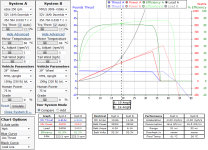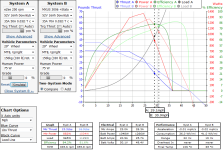Metallurgist
1 µW
Hi all! I've been lurking for a while now, educating myself on DIY electric bikes - there's a lot to learn. At this point I have a rough idea of what I'd like to build, but I’d like to know if anyone has any comments/suggestions/concerns on my proposed build. I plan on documenting this build for my own sake, but hopefully others can learn something from it.
General comments:
- I’m going the DIY route rather than buying an off-the-shelf e-bike, since I enjoy learning all the details about how things work to build it myself, and DIY lets me customize/improve as I see fit.
- All else equal, I would prefer to buy from companies that support the e-bike community (Grin is an obvious example).
- I don’t have a hard budget. I’d rather spend a little more to get better quality. I am okay with the costs of my tentative build below.
Typical use of finished e-bike:
- Purpose: ride for fun, possibly start commuting with it
- Rider: 6'5" 260 lb (1.95 m 118 kg)
- Cargo: non-battery cargo shouldn't exceed around 30 lb (14 kg), usually less
- Terrain: Fairly flat. Some longer, 2-3% grades, a few steep but short hills. Mix of paved trails/roads and pea gravel (rails-to-trails conversions)
- Speed: typically cruise around 18-20 mph (29-32 km/h), with moderate pedaling
- Range: Grin's Trip Simulator says my longest trip will come in a little over 600 Wh
- Power: roughly 1500 W peak pulled from the battery, max 750 W from the battery continuous (greater than a minute or two)
Desired characteristics/features:
- Still work well as an unpowered bicycle
- Not overly heavy (need to carry it up stairs)
- Reliable/robust/water-resistant
- Torque-based pedal assistance
- Quiet operation
- Unstressed battery - prefer to keep charge state between 80% and 20%
- Regenerative braking - mostly to save on brakes, since I won't get much extra range given my terrain/riding style. It would be nice to have a redundant braking system as well.
Donor bike:
Specialized Rockhopper, 4 year old 29er hardtail with disc brakes. The only changes made to it are a BodyFloat suspension seat post, new pedals, and a new saddle.
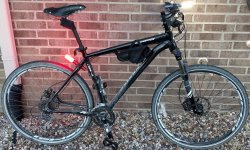
Core components of my tentative build:
- Cycle Analyst CA3-DP
- Grin Phaserunner
- EM3ev 14s6p triangle pack, 50.4 V, 20.4 Ah, 1028 Wh, Samsung 35E
- MXUS 3006RC rear direct drive hub, with Statorade
- Sempu torque sensor
--------------------------------------------------------------------------------------------------------------------------------------
Details on component selection:
Cycle Analyst
Since I plan on a DD hub, I will use the CA3-DP – I don’t need the external speedometer pickup. I will use the thermistor cable to monitor motor temp.
Controller:
Grin Phaserunner - FOC gives higher system efficiency, a quieter and cooler motor, and the potted construction gives durability and water resistance. The small size and appearance with clear potting are bonuses.
Battery:
Given a 600 Wh trip and trying to stay within the 80%-20% charge range, I need at least 1000 Wh. I planned on putting it inside the frame triangle to help keep weight evenly distributed, especially since I will likely install a rear rack if I end up using the bike for commuting. I originally considered the options below:
- EM3ev 14s7p rectangle, Samsung 35E cells (1180 Wh)
- EM3ev 14s6p triangle, Samsung 35E cells (1030 Wh) (current pick)
- Grin's LiGo packs, 10 to 12 connected together
Grin's LiGo packs are impressive. I really like the potting concept, but EM3ev’s new hard cases with cell-level fusing narrowed the gap in robustness. LiGo’s cost per Wh is roughly twice the EM3ev packs, and I don’t have the need to travel by air with my batteries.
That leaves the EM3ev packs. At 14s nominal of 52 V, 1500 W max from the battery is 4.8 A per cell on 6p and 4.1 A per cell on 7s. This is well within a 35E’s capability in short bursts. At max continuous power around 750 W, current draw is halved; the majority of my time will be spent at lower power than that. I don’t plan on riding at low ambient temps where the lower internal resistance of e.g. 30Q would be helpful. Overall, I don’t see any need to switch to a higher current cell than the 35E.
I was initially leaning towards the 14s7p rectangle – no one ever regrets having more battery. Given the size of the pack, I made a mock-up of the pack and put it in my frame’s triangle. With the pack flat on the downtube, I only have 15 mm between the pack and the cables under the top tube. I worry that by the time I put EM3ev’s triangle bag on the bike, the padding will be thick enough that it won’t fit.
At this point, I started wondering if I was being a little over-conservative with my battery selection. The 600 Wh trip value is conservative (modeled with slightly higher speed (1.7 mph aka 3 km/h)) and doesn’t include the efficiency improvement of FOC from the Phaserunner. cavallo pazzo and mrbill saw efficiency improvements of at least 10-20% changing to FOC, but their applications (low speed high torque operation uphill and heavy regen downhill) better take advantage of the benefits of FOC than my relatively flat terrain will. If I take off about 75 Wh to account for slightly lower speed and 7% for FOC, I end up with a trip needing more like 480 Wh. This takes the 14s6p triangle pack from just squeaking over the minimum 1000 Wh capacity to having a reasonable cushion above the minimum 800 Wh.
cavallo pazzo efficiency gains info: https://endless-sphere.com/forums/viewtopic.php?p=1116690#p1116690
mrbill efficiency gains info: https://mrbill.homeip.net/hybridBike.php#inf2asiControllerComparison
Motor:
I plan on using a rear DD hub, for the following reasons:
- Peak power output is high for a front hub on aluminum forks.
- Wanting regen means standard mid-drives are out, and a geared hub isn’t an option (without locking the freewheel).
- I prefer keeping the electric assist out of the human power part of the drivetrain, reducing strain on chains, sprockets, etc. Also, if one drive system fails (broken chain, cut wire, etc), the other can be used to limp home.
Given that, I am leaning towards Grin's MXUS 3006 rear cassette motor, injected with Statorade, and held in place with two Grin V4 torque arms. I like this motor since it uses cassettes rather than freewheels. The motor wind seems reasonable for my applications.
Cruising at 20 mph/32 kph – MXUS 3006 is slightly more efficient
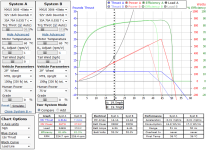
WOT – the slower wind of the MXUS 3006 gives a lower max speed, with peak power around 27 mph (43 km/h). I won’t be riding faster than 27 mph, so the loss in power above this speed isn’t an issue.
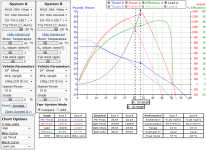
Technically, a trapezoidal controller (as modelled in Grin’s motor simulator) has about 7-8% higher top speed than with FOC. This translates to seeing about 2 mph (3 kph) less with the Phaserunner than the simulator shows. This doesn’t change my statement in the previous paragraph, and if I really need want more speed, field weakening is an option.
Justin’s explanation and data for unloaded speed of trap vs FOC: https://endless-sphere.com/forums/viewtopic.php?p=981766#p981500
Justin’s info on field weakening with FOC starting here: https://endless-sphere.com/forums/viewtopic.php?p=983536#p983536
Torque sensor:
Sempu from Grin. I like the high pole count (for quick response) combined with torque sensing, and it's cheaper than THUN or TDCM.
Charger:
Cycle Satiator, 48V 8A. What I like about this charger:
- Adjustable charge rate
- Adjustable charge termination voltage
- High max charge rate
- Historical battery data tracking
- Form factor (small, fanless)
- Reliable (lots of stories out there of charger failures)
Tires/Rims:
Schwalbe Marathon Plus, 700c x 45 aka 47-622 ISO. Great puncture resistance and low rolling resistance, in the fattest size they make. This will go on Grin’s 700c (29") DM24 Alex Rim in the rear.
Lighting:
Current setup: 18650 flashlights (Convoy S2+, white LED for front, red LED for rear) that I custom built with diffuser cones and flashed with custom firmware. They are mounted to the frame/handlebars with TwoFish LockBlocks. These are purely lights to be seen with; I haven’t done dark night riding where I needed a light to see the road.
I am considering upgrading with lights powered by the main bike battery:
- Front, to see with: Roxim X4 (power with Cycle Analyst, has StVZO shaped beam, which is a must for me)
- Rear, to be seen: Grin Electrolight
- Probably leave the current custom-made lights on the bike for extra visibility
--------------------------------------------------------------------------------------------------------------------------------------
With all that info, I am curious what everyone thinks. My main concerns are 1) whether my logic is sound on motor and battery selection, and 2) if I overlooked anything in planning and integration. (I know there are a lot of little details left, like connectors, CA inputs such as buttons, etc, but this post is long enough for a first round.)
Thanks in advance for the advice!
General comments:
- I’m going the DIY route rather than buying an off-the-shelf e-bike, since I enjoy learning all the details about how things work to build it myself, and DIY lets me customize/improve as I see fit.
- All else equal, I would prefer to buy from companies that support the e-bike community (Grin is an obvious example).
- I don’t have a hard budget. I’d rather spend a little more to get better quality. I am okay with the costs of my tentative build below.
Typical use of finished e-bike:
- Purpose: ride for fun, possibly start commuting with it
- Rider: 6'5" 260 lb (1.95 m 118 kg)
- Cargo: non-battery cargo shouldn't exceed around 30 lb (14 kg), usually less
- Terrain: Fairly flat. Some longer, 2-3% grades, a few steep but short hills. Mix of paved trails/roads and pea gravel (rails-to-trails conversions)
- Speed: typically cruise around 18-20 mph (29-32 km/h), with moderate pedaling
- Range: Grin's Trip Simulator says my longest trip will come in a little over 600 Wh
- Power: roughly 1500 W peak pulled from the battery, max 750 W from the battery continuous (greater than a minute or two)
Desired characteristics/features:
- Still work well as an unpowered bicycle
- Not overly heavy (need to carry it up stairs)
- Reliable/robust/water-resistant
- Torque-based pedal assistance
- Quiet operation
- Unstressed battery - prefer to keep charge state between 80% and 20%
- Regenerative braking - mostly to save on brakes, since I won't get much extra range given my terrain/riding style. It would be nice to have a redundant braking system as well.
Donor bike:
Specialized Rockhopper, 4 year old 29er hardtail with disc brakes. The only changes made to it are a BodyFloat suspension seat post, new pedals, and a new saddle.

Core components of my tentative build:
- Cycle Analyst CA3-DP
- Grin Phaserunner
- EM3ev 14s6p triangle pack, 50.4 V, 20.4 Ah, 1028 Wh, Samsung 35E
- MXUS 3006RC rear direct drive hub, with Statorade
- Sempu torque sensor
--------------------------------------------------------------------------------------------------------------------------------------
Details on component selection:
Cycle Analyst
Since I plan on a DD hub, I will use the CA3-DP – I don’t need the external speedometer pickup. I will use the thermistor cable to monitor motor temp.
Controller:
Grin Phaserunner - FOC gives higher system efficiency, a quieter and cooler motor, and the potted construction gives durability and water resistance. The small size and appearance with clear potting are bonuses.
Battery:
Given a 600 Wh trip and trying to stay within the 80%-20% charge range, I need at least 1000 Wh. I planned on putting it inside the frame triangle to help keep weight evenly distributed, especially since I will likely install a rear rack if I end up using the bike for commuting. I originally considered the options below:
- EM3ev 14s7p rectangle, Samsung 35E cells (1180 Wh)
- EM3ev 14s6p triangle, Samsung 35E cells (1030 Wh) (current pick)
- Grin's LiGo packs, 10 to 12 connected together
Grin's LiGo packs are impressive. I really like the potting concept, but EM3ev’s new hard cases with cell-level fusing narrowed the gap in robustness. LiGo’s cost per Wh is roughly twice the EM3ev packs, and I don’t have the need to travel by air with my batteries.
That leaves the EM3ev packs. At 14s nominal of 52 V, 1500 W max from the battery is 4.8 A per cell on 6p and 4.1 A per cell on 7s. This is well within a 35E’s capability in short bursts. At max continuous power around 750 W, current draw is halved; the majority of my time will be spent at lower power than that. I don’t plan on riding at low ambient temps where the lower internal resistance of e.g. 30Q would be helpful. Overall, I don’t see any need to switch to a higher current cell than the 35E.
I was initially leaning towards the 14s7p rectangle – no one ever regrets having more battery. Given the size of the pack, I made a mock-up of the pack and put it in my frame’s triangle. With the pack flat on the downtube, I only have 15 mm between the pack and the cables under the top tube. I worry that by the time I put EM3ev’s triangle bag on the bike, the padding will be thick enough that it won’t fit.
At this point, I started wondering if I was being a little over-conservative with my battery selection. The 600 Wh trip value is conservative (modeled with slightly higher speed (1.7 mph aka 3 km/h)) and doesn’t include the efficiency improvement of FOC from the Phaserunner. cavallo pazzo and mrbill saw efficiency improvements of at least 10-20% changing to FOC, but their applications (low speed high torque operation uphill and heavy regen downhill) better take advantage of the benefits of FOC than my relatively flat terrain will. If I take off about 75 Wh to account for slightly lower speed and 7% for FOC, I end up with a trip needing more like 480 Wh. This takes the 14s6p triangle pack from just squeaking over the minimum 1000 Wh capacity to having a reasonable cushion above the minimum 800 Wh.
cavallo pazzo efficiency gains info: https://endless-sphere.com/forums/viewtopic.php?p=1116690#p1116690
mrbill efficiency gains info: https://mrbill.homeip.net/hybridBike.php#inf2asiControllerComparison
Motor:
I plan on using a rear DD hub, for the following reasons:
- Peak power output is high for a front hub on aluminum forks.
- Wanting regen means standard mid-drives are out, and a geared hub isn’t an option (without locking the freewheel).
- I prefer keeping the electric assist out of the human power part of the drivetrain, reducing strain on chains, sprockets, etc. Also, if one drive system fails (broken chain, cut wire, etc), the other can be used to limp home.
Given that, I am leaning towards Grin's MXUS 3006 rear cassette motor, injected with Statorade, and held in place with two Grin V4 torque arms. I like this motor since it uses cassettes rather than freewheels. The motor wind seems reasonable for my applications.
Cruising at 20 mph/32 kph – MXUS 3006 is slightly more efficient

WOT – the slower wind of the MXUS 3006 gives a lower max speed, with peak power around 27 mph (43 km/h). I won’t be riding faster than 27 mph, so the loss in power above this speed isn’t an issue.

Technically, a trapezoidal controller (as modelled in Grin’s motor simulator) has about 7-8% higher top speed than with FOC. This translates to seeing about 2 mph (3 kph) less with the Phaserunner than the simulator shows. This doesn’t change my statement in the previous paragraph, and if I really need want more speed, field weakening is an option.
Justin’s explanation and data for unloaded speed of trap vs FOC: https://endless-sphere.com/forums/viewtopic.php?p=981766#p981500
Justin’s info on field weakening with FOC starting here: https://endless-sphere.com/forums/viewtopic.php?p=983536#p983536
Torque sensor:
Sempu from Grin. I like the high pole count (for quick response) combined with torque sensing, and it's cheaper than THUN or TDCM.
Charger:
Cycle Satiator, 48V 8A. What I like about this charger:
- Adjustable charge rate
- Adjustable charge termination voltage
- High max charge rate
- Historical battery data tracking
- Form factor (small, fanless)
- Reliable (lots of stories out there of charger failures)
Tires/Rims:
Schwalbe Marathon Plus, 700c x 45 aka 47-622 ISO. Great puncture resistance and low rolling resistance, in the fattest size they make. This will go on Grin’s 700c (29") DM24 Alex Rim in the rear.
Lighting:
Current setup: 18650 flashlights (Convoy S2+, white LED for front, red LED for rear) that I custom built with diffuser cones and flashed with custom firmware. They are mounted to the frame/handlebars with TwoFish LockBlocks. These are purely lights to be seen with; I haven’t done dark night riding where I needed a light to see the road.
I am considering upgrading with lights powered by the main bike battery:
- Front, to see with: Roxim X4 (power with Cycle Analyst, has StVZO shaped beam, which is a must for me)
- Rear, to be seen: Grin Electrolight
- Probably leave the current custom-made lights on the bike for extra visibility
--------------------------------------------------------------------------------------------------------------------------------------
With all that info, I am curious what everyone thinks. My main concerns are 1) whether my logic is sound on motor and battery selection, and 2) if I overlooked anything in planning and integration. (I know there are a lot of little details left, like connectors, CA inputs such as buttons, etc, but this post is long enough for a first round.)
Thanks in advance for the advice!


